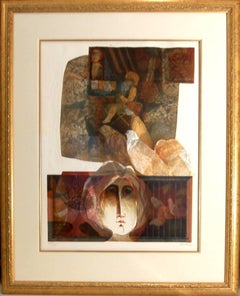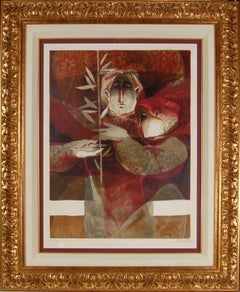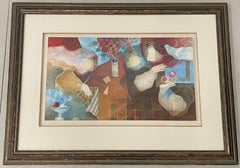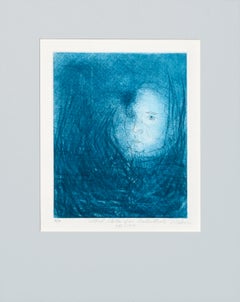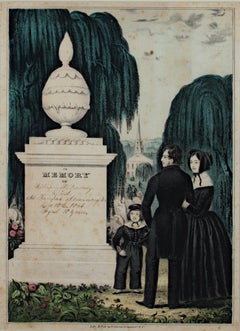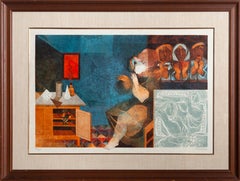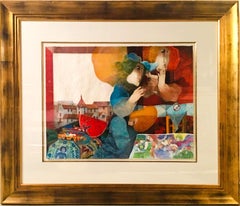Sunol Alvar Figurative Prints
to
6
Overall Width
to
Overall Height
to
1
8
847
382
381
308
6
3
4
2
5
4
3
3
1
1
1
6
3
6
Artist: Sunol Alvar
Women with Dove and Flowers
By Sunol Alvar
Located in San Francisco, CA
Artist: Sunol Alvar
Title: Women with dove and Flowers
Year: c.1980
Medium: Colors lithograph with embossing
Edition: Numbered 28/195 in pencil
Paper: Arches
Image size: 16.75 x 21...
Category
1970s Romantic Sunol Alvar Figurative Prints
Materials
Lithograph
From the Barcelona suite
By Sunol Alvar
Located in San Francisco, CA
Artist: Alvar
Title: From Barcelona Suite
Year: 1979
Medium: Color lithograph with embossing
Edition: Numberd 145/185 in pencil
Paper: Arches
Image siz...
Category
1970s Romantic Sunol Alvar Figurative Prints
Materials
Lithograph
From the, The Barcelona Suite
By Sunol Alvar
Located in San Francisco, CA
Artist: Alvar Sunol Munoz-Ramos (Spanish, born 1935)
Title: From Barcelona Suite
Year: 1979
Medium: Color lithograph with embossing
Edition: Numbered 1...
Category
1970s Romantic Sunol Alvar Figurative Prints
Materials
Lithograph
Woman with Birds
By Sunol Alvar
Located in San Francisco, CA
Artist: Alvar
Title: Woman with Birds
Year: c.1980
Medium: Color lithograph
Paper: Wove
Image size: 18.5 x 24.5 inches
Framed size: 26.5 x 32.65 inc...
Category
Late 20th Century Romantic Sunol Alvar Figurative Prints
Materials
Lithograph
Alvar Sunol Pencil Signed Lithograph C.1970s
By Sunol Alvar
Located in San Francisco, CA
Alvar Sunol Pencil Signed Lithograph C.1970s
Three women around a table
Dimensions 21.5" wide x 12.5" high
The frame measures 32.75" wide x...
Category
Mid-20th Century Abstract Impressionist Sunol Alvar Figurative Prints
Materials
Lithograph
Untitled III
By Sunol Alvar
Located in San Francisco, CA
Artist: Alvar
Title: Untitled III
Year: c.1990
Medium: Color lithograph with embossing
Edition: Numbered 148/225 in pencil
Paper: Arches
Image size: 16.5 x 22.5 inches
Framed s...
Category
Late 20th Century Romantic Sunol Alvar Figurative Prints
Materials
Lithograph
Related Items
"Altered States of an Autorittrati" 3rd State, Modernist Blue Self-Portrait
By I. Colon
Located in Soquel, CA
Bold modernist self portrait in blue, a lithograph by California artist I. Colon (20th Century). Numbered, titled, and signed along the bottom edge ("2/6 "Altered States of an Aut...
Category
Late 20th Century Abstract Impressionist Sunol Alvar Figurative Prints
Materials
Paper, Ink, Lithograph
$399 Sale Price
20% Off
H 18 in W 14 in D 0.25 in
19th century color lithograph figures cemetery willow tree memorial headstone
By Nathaniel Currier
Located in Milwaukee, WI
The present hand-colored lithograph was produced as part of the funeral and mourning culture in the United States during the 19th century. Images like this were popular as ways of remembering loved ones, an alternative to portraiture of the deceased. This lithograph shows a man, woman and child in morning clothes next to an urn-topped stone monument. Behind are additional putto-topped headstones beneath weeping willows, with a steepled church beyond. The monument contains a space where a family could inscribe the name and death dates of a deceased loved one. In this case, it has been inscribed to a young Civil War soldier:
William W. Peabody
Died at Fairfax Seminary, VA
December 18th, 1864
Aged 18 years
The young Mr. Peabody probably died in service for the Union during the American Civil War. Farifax Seminary was a Union hospital and military headquarters in Alexandria, Virginia. The hospital served nearly two thousand soldiers during the war time. Five hundred were also buried on the Seminary's grounds.
13.75 x 9.5 inches, artwork
23 x 19 inches, frame
Published before 1864
Inscribed bottom center "Lith. & Pub. by N. Currier. 2 Spruce St. N.Y."
Framed to conservation standards using 100 percent rag matting and TruVue Conservation Clear glass, housed in a gold gilded moulding.
Nathaniel Currier was a tall introspective man with a melancholy nature. He could captivate people with his piercing stare or charm them with his sparkling blue eyes. Nathaniel was born in Roxbury, Massachusetts on March 27th, 1813, the second of four children. His parents, Nathaniel and Hannah Currier, were distant cousins who lived a humble yet spartan life. When Nathaniel was eight years old, tragedy struck. Nathaniel’s father unexpectedly passed away leaving Nathaniel and his eleven-year-old brother Lorenzo to provide for the family. In addition to their mother, Nathaniel and Lorenzo had to care for six-year-old sister Elizabeth and two-year-old brother Charles. Nathaniel worked a series of odd jobs to support the family, and at fifteen, he started what would become a life-long career when he apprenticed in the Boston lithography shop of William and John Pendleton.
A Bavarian gentleman named Alois Senefelder invented lithography just 30 years prior to young Nat Currier’s apprenticeship. While under the employ of the brothers Pendleton, Nat was taught the art of lithography by the firm’s chief printer, a French national named Dubois, who brought the lithography trade to America.
Lithography involves grinding a piece of limestone flat and smooth then drawing in mirror image on the stone with a special grease pencil. After the image is completed, the stone is etched with a solution of aqua fortis leaving the greased areas in slight relief. Water is then used to wet the stone and greased-ink is rolled onto the raised areas. Since grease and water do not mix, the greased-ink is repelled by the moisture on the stone and clings to the original grease pencil lines. The stone is then placed in a press and used as a printing block to impart black on white images to paper.
In 1833, now twenty-years old and an accomplished lithographer, Nat Currier left Boston and moved to Philadelphia to do contract work for M.E.D. Brown, a noted engraver and printer. With the promise of good money, Currier hired on to help Brown prepare lithographic stones of scientific images for the American Journal of Sciences and Arts. When Nat completed the contract work in 1834, he traveled to New York City to work once again for his mentor John Pendleton, who was now operating his own shop located at 137 Broadway. Soon after the reunion, Pendleton expressed an interest in returning to Boston and offered to sell his print shop to Currier. Young Nat did not have the financial resources to buy the shop, but being the resourceful type he found another local printer by the name of Stodart. Together they bought Pendleton’s business.
The firm ‘Currier & Stodart’ specialized in "job" printing. They produced many different types of printed items, most notably music manuscripts for local publishers. By 1835, Stodart was frustrated that the business was not making enough money and he ended the partnership, taking his investment with him. With little more than some lithographic stones, and a talent for his trade, twenty-two year old Nat Currier set up shop in a temporary office at 1 Wall Street in New York City. He named his new enterprise ‘N. Currier, Lithographer’
Nathaniel continued as a job printer and duplicated everything from music sheets to architectural plans. He experimented with portraits, disaster scenes and memorial prints, and any thing that he could sell to the public from tables in front of his shop. During 1835 he produced a disaster print Ruins of the Planter's Hotel, New Orleans, which fell at two O’clock on the Morning of the 15th of May 1835, burying 50 persons, 40 of whom Escaped with their Lives. The public had a thirst for newsworthy events, and newspapers of the day did not include pictures. By producing this print, Nat gave the public a new way to “see” the news. The print sold reasonably well, an important fact that was not lost on Currier.
Nat met and married Eliza Farnsworth in 1840. He also produced a print that same year titled Awful Conflagration of the Steamboat Lexington in Long Island Sound on Monday Evening, January 18, 1840, by which melancholy occurrence over One Hundred Persons Perished. This print sold out very quickly, and Currier was approached by an enterprising publication who contracted him to print a single sheet addition of their paper, the New York Sun. This single page paper is presumed to be the first illustrated newspaper ever published.
The success of the Lexington print launched his career nationally and put him in a position to finally lift his family up. In 1841, Nat and Eliza had their first child, a son they named Edward West Currier. That same year Nat hired his twenty-one year old brother Charles and taught him the lithography trade, he also hired his artistically inclined brother Lorenzo to travel out west and make sketches of the new frontier as material for future prints. Charles worked for the firm on and off over the years, and invented a new type of lithographic crayon which he patented and named the Crayola. Lorenzo continued selling sketches to Nat for the next few years.
In 1843, Nat and Eliza had a daughter, Eliza West Currier, but tragedy struck in early 1847 when their young daughter died from a prolonged illness. Nat and Eliza were grief stricken, and Eliza, driven by despair, gave up on life and passed away just four months after her daughter’s death.
The subject of Nat Currier’s artwork changed following the death of his wife and daughter, and he produced many memorial prints and sentimental prints during the late 1840s. The memorial prints generally depicted grief stricken families posed by gravestones (the stones were left blank so the purchasers could fill in the names of the dearly departed). The sentimental prints usually depicted idealized portraits of women and children, titled with popular Christian names of the day.
Late in 1847, Nat Currier married Lura Ormsbee, a friend of the family. Lura was a self-sufficient woman, and she immediately set out to help Nat raise six-year-old Edward and get their house in order. In 1849, Lura delivered a son, Walter Black Currier, but fate dealt them a blow when young Walter died one year later. While Nat and Lura were grieving the loss of their new son, word came from San Francisco that Nat’s brother Lorenzo had also passed away from a brief illness. Nat sank deeper into his natural quiet melancholy. Friends stopped by to console the couple, and Lura began to set an extra place at their table for these unexpected guests. She continued this tradition throughout their lives.
In 1852, Charles introduced a friend, James Merritt Ives, to Nat and suggested he hire him as a bookkeeper. Jim Ives was a native New Yorker born in 1824 and raised on the grounds of Bellevue Hospital where his father was employed as superintendent. Jim was a self-trained artist and professional bookkeeper. He was also a plump and jovial man, presenting the exact opposite image of his new boss.
Jim Ives met Charles Currier through Caroline Clark, the object of Jim’s affection. Caroline’s sister Elizabeth was married to Charles, and Caroline was a close friend of the Currier family. Jim eventually proposed marriage to Caroline and solicited an introduction to Nat Currier, through Charles, in hopes of securing a more stable income to support his future wife.
Ives quickly set out to improve and modernize his new employer’s bookkeeping methods. He reorganized the firm’s sizable inventory, and used his artistic skills to streamline the firm’s production methods. By 1857, Nathaniel had become so dependent on Jims’ skills and initiative that he offered him a full partnership in the firm and appointed him general manager. The two men chose the name ‘Currier & Ives’ for the new partnership, and became close friends.
Currier & Ives produced their prints in a building at 33 Spruce Street where they occupied the third, fourth and fifth floors. The third floor was devoted to the hand operated printing presses that were built by Nat's cousin, Cyrus Currier, at his shop Cyrus Currier & Sons in Newark, NJ. The fourth floor found the artists, lithographers and the stone grinders at work. The fifth floor housed the coloring department, and was one of the earliest production lines in the country. The colorists were generally immigrant girls, mostly German, who came to America with some formal artistic training. Each colorist was responsible for adding a single color to a print. As a colorist finished applying their color, the print was passed down the line to the next colorist to add their color. The colorists worked from a master print displayed above their table, which showed where the proper colors were to be placed. At the end of the table was a touch up artist who checked the prints for quality, touching-in areas that may have been missed as it passed down the line. During the Civil War, demand for prints became so great that coloring stencils were developed to speed up production.
Although most Currier & Ives prints were colored in house, some were sent out to contract artists. The rate Currier & Ives paid these artists for coloring work was one dollar per one hundred small folios (a penny a print) and one dollar per one dozen large folios. Currier & Ives also offered uncolored prints to dealers, with instructions (included on the price list) on how to 'prepare the prints for coloring.' In addition, schools could order uncolored prints from the firm’s catalogue to use in their painting classes.
Nathaniel Currier and James Merritt Ives attracted a wide circle of friends during their years in business. Some of their more famous acquaintances included Horace Greeley, Phineas T. Barnum, and the outspoken abolitionists Rev. Henry Ward, and John Greenleaf Whittier (the latter being a cousin of Mr. Currier).
Nat Currier and Jim Ives described their business as "Publishers of Cheap and Popular Pictures" and produced many categories of prints. These included Disaster Scenes, Sentimental Images, Sports, Humor, Hunting Scenes, Politics, Religion, City and Rural Scenes, Trains, Ships, Fire Fighters, Famous Race Horses, Historical Portraits, and just about any other topic that satisfied the general public's taste. In all, the firm produced in excess of 7500 different titles, totaling over one million prints produced from 1835 to 1907.
Nat Currier retired in 1880, and signed over his share of the firm to his son Edward. Nat died eight years later at his summer home 'Lion’s Gate' in Amesbury, Massachusetts. Jim Ives remained active in the firm until his death in 1895, when his share of the firm passed to his eldest son, Chauncey.
In 1902, faced will failing health from the ravages of Tuberculosis, Edward Currier sold his share of the firm to Chauncey Ives...
Category
Mid-19th Century Romantic Sunol Alvar Figurative Prints
Materials
Watercolor, Lithograph
19th century color lithograph watercolor landscape figurative animal print
By Nathaniel Currier
Located in Milwaukee, WI
The present hand-colored lithograph presents the viewer with a hunting scene in a picturesque landscape. In the foreground, a man approaches two partridges as his two pointers prepare to flush them out. Beyond, a white fence draws our eyes to the homestead in the distance. Images like this one show how people in the United States were trying to identify themselves as a new nation in the North American landscape - as separate from their European counterparts but with similar similar and specific wildlife and magesties of nature. It also identifies hunting in this landscape as an American pastime.
9.25 x 12.5 inches, artwork
18.38 x 22 inches, frame
Entitled bottom center "Partridge Shooting...
Category
Mid-19th Century Romantic Sunol Alvar Figurative Prints
Materials
Watercolor, Lithograph
abstract composition
By Marie Raymond
Located in Belgrade, MT
This color lithograph is part of my private collection since the 1970's. Marie Raymond was a pioneer post WWII painter of her generation. She was a lyrical abstractionist of her time...
Category
Mid-20th Century Abstract Expressionist Sunol Alvar Figurative Prints
Materials
Color, Lithograph
Heart
By Jim Dine
Located in Winterswijk, NL
Color offset lithograph
Made for an exhibition at the Galerie Maeght
Paris, 12 April - 20 May 1983.
Image in great condition, marginal defects
Category
1980s Romantic Sunol Alvar Figurative Prints
Materials
Lithograph
Bacon, Portrait Isabel Rawsthorne, 2003 (after)
By Francis Bacon
Located in Fairfield, CT
Artist: Francis Bacon (1909-1992)
Title: Portrait Isabel Rawsthorne
Year: 2003
Medium: Offset Lithograph on premium paper
Size: 39.25 x 27.5 inches
Condition: Excellent
Notes: Publis...
Category
Early 2000s Abstract Expressionist Sunol Alvar Figurative Prints
Materials
Lithograph, Offset
Dutch Masters, Larry Rivers
By Larry Rivers
Located in Fairfield, CT
Artist: Larry Rivers (1923-2002)
Title: Dutch Masters
Year: 1991
Medium: Lithograph and silkscreen on wove paper
Edition: 23/500, plus proofs
Size: 25 x 3...
Category
1990s Abstract Expressionist Sunol Alvar Figurative Prints
Materials
Lithograph, Screen
Johns, Two Cup Picasso (ULAE 123) (after)
By Jasper Johns
Located in Fairfield, CT
Artist: Jasper Johns (1930)
Title: Two Cup Picasso
Year: 1981
Medium: Lithograph and silkscreen on premium paper
Size: 14 x 10.5 inches
Inscription: Signed & dated with the artist's ...
Category
1970s Abstract Expressionist Sunol Alvar Figurative Prints
Materials
Lithograph
Illustration for W. S. Kenilworth-Lithograph by Camulle Roqueplan-19th Century
Located in Roma, IT
Lithograph realized by Camulle Roqueplan (1803-1855) to illustrate Walter Scott's Kenilworth.
Very good condition.
Category
19th Century Romantic Sunol Alvar Figurative Prints
Materials
Lithograph
$236
H 11.42 in W 8.08 in D 0.04 in
"Venus Noire", Rufino Tamayo, Figurative Abstraction, Etching, 30x22 in.
By Rufino Tamayo
Located in Dallas, TX
"Venus Noire" by Rufino Tamayo is a Figurative Abstraction lithograph limited edition measuring 30x22 in. The piece is framed beautifully with a white mat in a gold and black frame u...
Category
1960s Abstract Expressionist Sunol Alvar Figurative Prints
Materials
Lithograph
$4,850
H 30 in W 22 in D 1 in
Serigraphie Fernand Leger
By Fernand Léger
Located in Belgrade, MT
This print is part of my private collection. They were published in a numbered unsigned edition of 1000, and a signed edition of 200, printed by Serifraphie Fernand Leger, Paris and ...
Category
Mid-20th Century Abstract Expressionist Sunol Alvar Figurative Prints
Materials
Lithograph
Richard Serra 'Stop B S' Signed, Limited Edition Print
By Richard Serra
Located in San Rafael, CA
Richard Serra (American, B. 1938)
Stop B S (G. 2024), 2004.
From the portfolio 'Artists Coming Together'
Lithograph on wove paper
Signed in pencil and numbered 127/250 (there were al...
Category
Early 2000s Abstract Sunol Alvar Figurative Prints
Materials
Lithograph
$4,800
H 62.5 in W 51.5 in D 1.5 in
Previously Available Items
Sur La Table, Framed Cubist Lithograph by Sunol Alvar
By Sunol Alvar
Located in Long Island City, NY
A woman sits admiring a variety of objects above and below an open cabinet door in this print by Sunol Alvar. A trio appear to be singing in the top right and a duo playing music bel...
Category
1980s Modern Sunol Alvar Figurative Prints
Materials
Lithograph
Mexican Painter
By Sunol Alvar
Located in Long Island City, NY
Three compositions combined in this work by the artist, on the left two women sit outside at night with a flute which continues to the right with two women playing the piano. At the ...
Category
1980s Modern Sunol Alvar Figurative Prints
Materials
Lithograph
Two Women with Guitar
By Sunol Alvar
Located in Wilton Manors, FL
Beautiful abstract lithograph by Spanish artist, Sunol Alvar (b.1935). Intaglio lithograph, image measures 20 x 26 inches; 29 x 35 inches framed. Signed and numbered 120/150 by arti...
Category
1970s Abstract Sunol Alvar Figurative Prints
Materials
Lithograph
Embossed lithograph
By Sunol Alvar
Located in San Francisco, CA
This exceptional lithograph is immediately recognizable as the work of Spanish artist Sunol Alvar (1935-). This print has beautiful embossing as well as rich colors. The image measu...
Category
Late 20th Century Romantic Sunol Alvar Figurative Prints
Materials
Lithograph
Sunol Alvar figurative prints for sale on 1stDibs.
Find a wide variety of authentic Sunol Alvar figurative prints available for sale on 1stDibs. You can also browse by medium to find art by Sunol Alvar in lithograph and more. Much of the original work by this artist or collective was created during the 20th century and is mostly associated with the modern style. Not every interior allows for large Sunol Alvar figurative prints, so small editions measuring 30 inches across are available. Customers who are interested in this artist might also find the work of John Mix Stanley, Eugene Delacroix, and Pati Bannister. Sunol Alvar figurative prints prices can differ depending upon medium, time period and other attributes. On 1stDibs, the price for these items starts at $1,200 and tops out at $1,850, while the average work can sell for $1,625.
